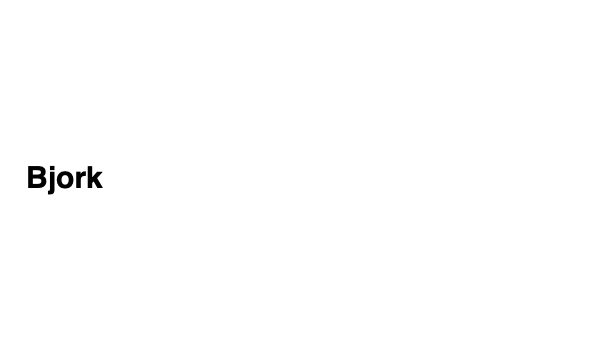
Regardless of the genre, Björk’s music has always been highly unique. This is because her music is made with a unique combination of vocals and electronic instruments, such as drums and keyboards. This combination creates some of the most beautiful music in the world today. Her newest album, Homogenic, is no exception. This album features many collaborations with artists such as Madonna, Michael Jackson, and Prince, and has been her most commercially successful album to date.

During her first year as a solo artist, Icelandic singer Bjork’s first solo hit was “Human Behaviour.” This song was written when Bjork was a teenager and was her first international single. Its lyrics take an animal’s point of view to express human nature.
This song was inspired by Bjork’s personal experiences with nature documentaries. She is known for her enchanting voice and unique songwriting. It is a mid-tempo song with a cool melodic riff. It also features a sample from a Brazilian musician named Antonio Carlos Jobim.
The percussion intro is a combination of African and Asian rhythms. This song was originally called “Murder for two” but was later renamed “Human Behaviour.” The melody line was also written by Bjork for her Sugarcubes album.
Bjork teamed up with producer Nellee Hooper, who had worked with Massive Attack. This song also features a sample of “Go Down Dying” by Antonio Carlos Jobim. It was nominated for six MTV Video Music Awards.
The song also features symphonic inspired hip hop backbeats. Its lyrics, however, are hard to understand. Bjork said that her success was measured by the fact that she made listeners feel something.
“Human Behaviour” was also nominated for a Grammy Award. It was a hit in the US and peaked at number two on the dance charts. The video, directed by Michel Gondry, was nominated for Best Breakthrough Video.
Bjork also released an acoustic version of this album that featured sounds from a Leonardo da Vinci keyboard. She performed this song live for the first time since 2007. Currently, Bjork is scheduled to play at festivals in Denmark, Spain and France. She also recently returned to Later… with Jools Holland, marking her first TV performance in eight years.
Bjork is considered to be one of the most important musical artists of the 1990s. The singer has an unparalleled live performance ability. Her songs are also very diverse. The lyrics are often trippy and not very easy to understand. Nevertheless, fans of Bjork will enjoy her music.
Having reached a point of commercial success with her first two studio albums, Bjork decided to focus more on her personal expression. Her third album, Homogenic, was released on September 22, 1997. The album features a host of collaborations, including LFO’s Mark Bell and Post contributor Howie B.
Homogenic is Bjork’s most adventurous and emotionally layered album yet. The sound of Homogenic combines a cinematic scale with electronica and symphonic variables. The album also features Bjork’s vocals in a more powerful and provocative manner than she’s used in previous albums. This was a huge departure for Bjork, who was once known for her playful worldview.
The album is accompanied by a mini-orchestra conducted by Isobel Griffiths. Bjork’s vocals are occasionally left to improvise, giving the album a greater sense of depth.
The first single released off of Homogenic is “Hunter.” The track features a traditional Icelandic accordion and sparse beats. It’s a dark, but also hopeful song. It establishes the setting of the album.
Another track that appears on Homogenic is “All Neon Like.” This song seems to be about healing a lover. It’s also an interesting song because it features the traditional Icelandic choir singing technique.
The fourth single released off of Homogenic is “Alarm Call.” This track features a church bell-laced beat and an enticing rhythm. The lyrics describe a person who is unable to love another person. It’s one of the most interesting tracks on the album.
Another song that appears on the Homogenic album is “Unravel.” This song features distant electronic beats. It’s a powerful and intimidating song. The lyrics are a bit unsettling. The song ends with Bjork’s voice saying, “You will not see me in your dreams.”
“Immature” was also released in early 1999. This song features Bjork’s vocals reciting four lines over and over. It seems to describe Iceland through sound. The song also features a saxophone. The song was written in response to a breakup with Goldie.
Bjork’s next album, Fossora, is set for release on September 30. It’s the first Bjork album to be released in over a decade. The album features some of her favorites from Homogenic, along with some new tracks.
Throughout her career, Icelandic singer and songwriter Bjork has collaborated with artists in a variety of fields. She has been a prolific songwriter and performer for more than two decades. She has written more than 200 songs and has released nine studio albums. The artist has also starred in two feature films, acting as the main character in Dancer in the Dark (2000).
Bjork has a long history of collaborations with image-makers, photographers, videographers, and music producers. She has worked with names such as Skunk Anansie, Tricky, Debut, Homogenic, and Matthew Herbert. She has also worked with a variety of A-list filmmakers, such as David Attenborough and Lars von Trier.
In 2004, Bjork performed a song called “Oceania” at the 2004 Summer Olympics in Athens. The track was a collaboration with British choir London Voices. It was later released to radio stations. It also charted in the UK at number 26. It was later featured on the soundtrack to the film The Northman.
Bjork has also been active in the environment, contributing to a series of foundations to teach children about nature. She was awarded the Inspiration Award from the Q Magazine Awards for her efforts.
Among her latest projects is the virtual reality exhibit Bjork Digital. It has toured Europe, and is set to stop in Los Angeles and London this September. In addition to music, the exhibit features video and digital works. The project began with Bjork’s involvement in the SHOWstudio visual collaborative project.
The project combines new instrumentation, stage spectacle, and an iPad app emporium. Its first TV show, Atta Raddir, aired in February 2011. It featured eight Bjork songs, including “Sun in My Mouth”, “Oceania”, and “Earth Intruders”.
Bjork’s latest album, Vulnicura, was released on 20 January. It features ten tracks. It was released with a companion LP of string arrangements. Bjork has also worked with Arca, Sjon, and Timbaland. The album was produced by Howie B. and Graham Massey. It was nominated for a BRIT Award.
In addition to her work on albums, Bjork has contributed production, remixing, and songwriting to other artists.
Throughout her career, Icelandic musician and multi-disciplinary artist Bjork has aligned herself with a number of political causes. From the environmental movement to the fight against misogyny, Bjork has been passionate about protecting nature. And she has been honoured at home and abroad.
During her career, Bjork has been known to experiment and push boundaries, making her one of the most exciting artists to come out of the 21st century. She has taken on many different roles and shaped her image, from the enigmatic childlike figure of the ’90s to the ethereal beauty of the newer work.
Bjork has defied genre boundaries and has worked with many of the most important musicians in the pop world. Her work has been lauded by many, including Jay Z, Radiohead, and SZA. In her latest album, she takes a more spiritual approach. It features Guy Sigsworth’s medieval instrumentation and is lyrically “out there”. Bjork is also known to collaborate with Sir David Attenborough on a documentary about nature.
Bjork also campaigns heavily for the environment and education. She has spoken out about corruption in Icelandic politics. In July, she pulled out of a music festival in Serbia because of her commitment to the country’s independence.
In the ’90s, Bjork was a solo artist. She later joined post-punk group Kukl. They originally formed as a supergroup, but eventually broke up due to infighting.
Bjork has spent the past twenty years as a songwriter and producer. She has collaborated with artists including Jay Z, Timbaland, and David Attenborough. She has been honored at home and abroad, and her music has been played by major radio stations around the world.
Bjork has also become a mother figure to hordes of online fans. She has a large social media following, with many fans coming from queer and youth communities. She also has a dedicated fan base in Iceland, where she lives. A plethora of hordes of online fans flood the internet with toxicity-free hype.
Bjork has also been the subject of controversy. During her final set in China, she chanted “Tibet!”, which many Chinese took as a sign of favor for the Tibetan Freedom movement.
Frequently Asked Questions
Max Ernst Among the most famous artists of the twentieth century, Max Ernst was a
Angelina Jolie DCMG – An Icon in Hollywood Whether you love her as an actress
Barack Hussein Obama II Barack Hussein Obama II served as the 44th President of the
A Brief Look at Ben Affleck Benjamin Affleck is a well-known American actor and director.
Alicia Keys Alicia Keys is a famous American singer, songwriter and pianist. She was born